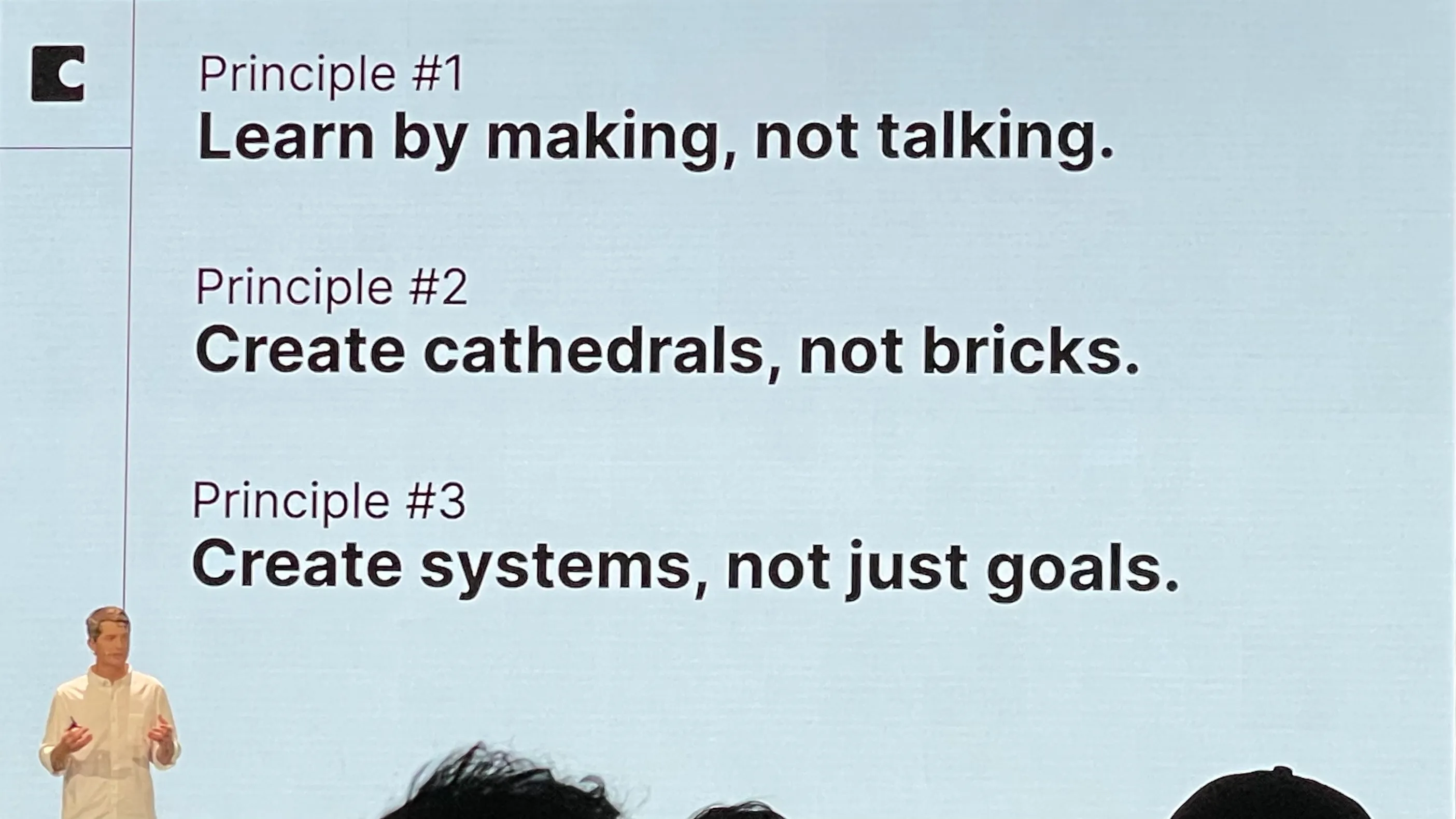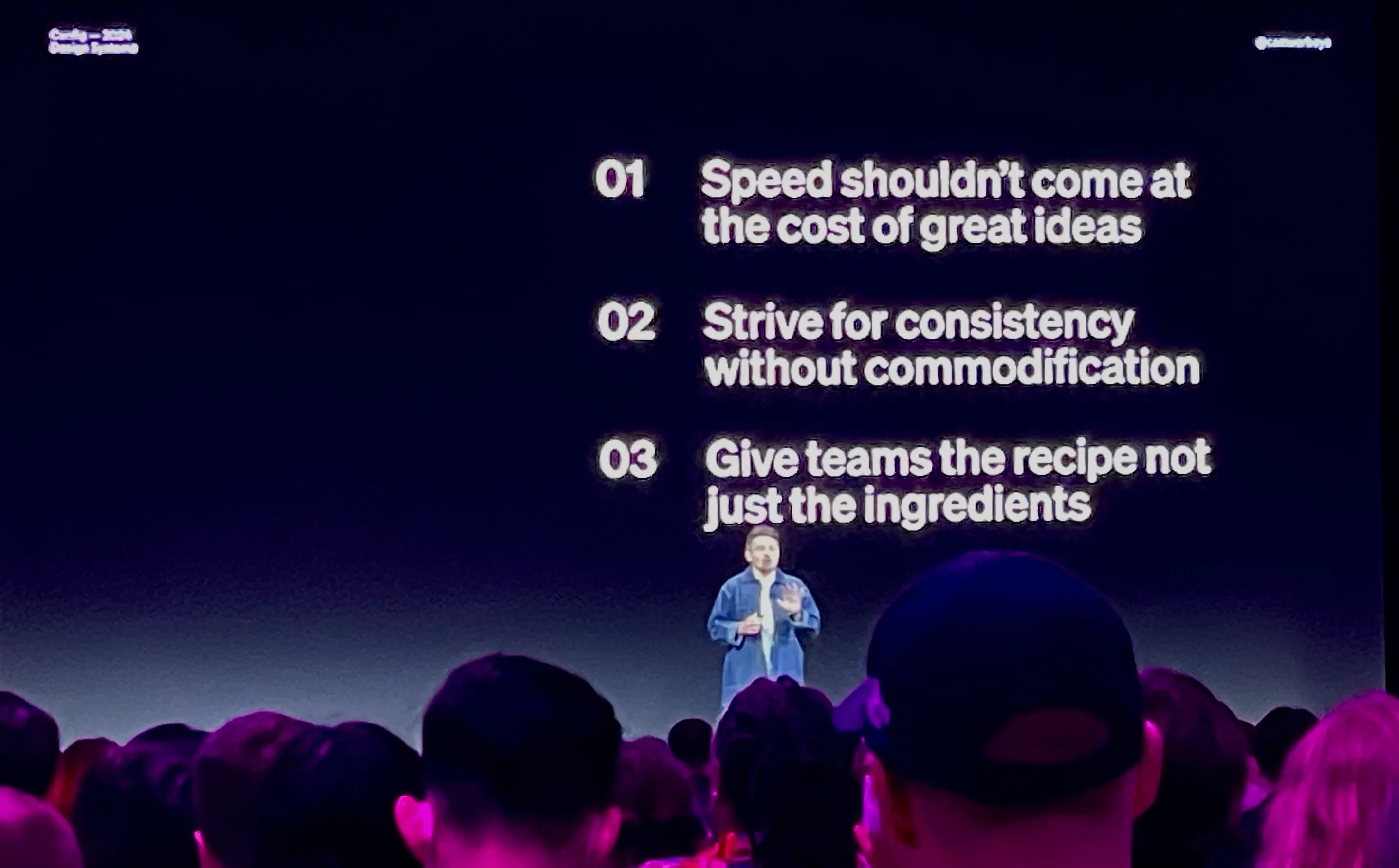Config 2024 Day Two
Starting off day two strong, I was lucky enough to get upgraded access to the leadership collective, massive thanks to our Figma rep for pulling in that favor.
Opening Keynote
Leaving Fingerprints
Karla and Nash kicked off the talks with Leaving fingerprints: product, design & stories at The Browser Company. The talk was full of inspirational stories of creating unique products and telling the story that scares you the most. They encouraged us to look outside of technology, and remember that when we set out to make great products we’re setting out to tell stories, real, vulnerable, and human stories.

Shitty Robots
Closing out the opening ceremony was Simone Giertz with Why shitty robots are the antidote of perfectionism. I’ve been an avid follower of Simone through her YouTube for years. Getting to see her on stage was great, and the take aways from her talk felt incredibly valuable, even if you had no idea who she was prior.

Session 1: Leadership Collective
During the short break between the opening ceremony and the first set of sessions I was able to catch up with and grab a picture with Miggi from Figgi!

Rituals to Unbreak Planning
Originally I was planning on attending Scaling Up Design Systems, but I’ll have to settle for the recording of Nate Baldwin’s opinions. Because the leadership collective offers an additional track, I thought my time would be better spent at this talk by Sashir Mehrota and Yuhki Yamashita. At last year’s config they gave a talk that I loved called Rituals of Modern Product Teams.
This year they decided to move onto the next step in the process and focus on planning, something that in their opinion is largely broken across the industry. As they put it “Planning algorithms today produce winners and losers, resulting in an unproductive zero-sum game.”
Sashir and Yuhki go deep into how they think we can all improve planning, providing a few new techniques, as well as a critical look at the reality of planning activities, even going so far as to suggest that ideally only 10% of our time should be spent on planning each quarter.

One important takeaway I want to bring back to the teams I work with is to remember that exhaustive planning is exhausting, and often well beyond what needs to be done in reality. Another being the YouTube Hoodie Squad mindset, which helps reinforce the idea that we should strive for individuals only being dedicated to a single team, and those who are on multiple teams are an exception that we should work to reduce or eliminate as much as possible.
Session 3: Building (your own) PM Principles
I wasn’t really sure what to expect going into this session. Having been moonlighting as a PM for the last few years I have a decent understanding of what goes into the job, and was curious to hear others’ takes on the role.
Hard Truths About the Future of Product Management
I didn’t really jive with the first talk Hard Truths About the Future of Product Management by Claire Vo, it felt like a weird tacit admission of the fact that corporate America has decided not to promote younger people into more senior roles, and that we should all just accept that fact and become “Super ICs.” The entire talk came off as the old advice of “take on more to get ahead,” never mind the fact that the corporate climate for the last decade or so has often proven that all taking on more results in is frustration and burnout.

I’m all for pushing yourself to get better at your job, hell I’ve become a full-stack product polyglot, I studied front-end and design in school, learned enough back-end code to understand and explore personal projects, and then learned product management on-the-job because we needed someone to do it, and I had already started doing half of the work because that’s what a good leader does. However, I’d never tell someone that they needed to do that, or that they should be expected to do or know all those things in order to be a product manager.
The fact that a significant portion of the audience was Gen Z individuals who are likely in their first or second corporate jobs made for a rather interesting set of conversations during and after the talk. I have a feeling the term “Super IC” is quickly going to become meme material among the more cyclical audience members.
Turning Ambiguity into Clarity
The second talk of the session, Turning Ambiguity into Clarity: Learnings and Principles by Lane Patrick Shackleton on the other hand, had a much more positive and practical vibe.

As a long-time listener of the ShopTalk Show, the first principle Lane presented: “Learn by making, not Talking” is right up there with “Just Build Websites.” It’s advice I’ve long followed and have applied in many places in my career and personal life. The only way to get better at something is to be bad at it first. Sure you can read a book or watch a YouTube video, but until you actually try whatever it is you’re trying to learn, you’ll never build the skills to complete the job. I can’t remember the exact quote, but it goes something like “Being really bad as something is the first step to not being really bad at something.”
His second principle: “Create cathedrals, not bricks,” is great advice for anyone who is looking to inspire people into action, not just PMs or someone in a management position. The idea here is that you need to show your team what they’re really working on; show everyone the vision, and inspire them to achieve that vision. You don’t build a beautiful cathedral by having someone create bricks, someone else put those bricks into a bucket, someone else carry that bucket, and someone else build a wall. They’ll likely wind up building a decent structure, but unless everyone is bought in to the vision at every step of the process, you’re unlikely to build Notre Dame.
The final principle: “Create systems, not just goals,” implores us to take action towards our successes. Goals are great, but as Lane points out in his talk:
You don’t rise to the level of your goals, you fall to the level of your systems
Rather than setting goals and hoping that you achieve them, set up systems that reinforce the behavior that moves you towards that goal. A personal example would be my goal to write at least 1 blog post a week. Rather than just hoping that happens, I set aside a little bit of time a few days a week to write, sometimes writing is easy and the posts come naturally, other times Sunday rolls around and I have to fall back to another system where I force myself to write a post before I am allowed any “R&R” style activities.
Session 4: Beyond the Hype: A Critical Look at Design Systems
The Broken Promises of Design Systems
Cam Worboys from Cash App kicked off this session with a cutting analysis of what design systems are, what they’re not, and some false promises or mistakes we may have made along the way.

We (Design Systems) can’t prevent bad [design] decisions.
At the end of the day, no matter how much time, effort, or pure willpower we pour into our design systems, if someone wants to make a bad design decision they will. You can easily make boring or uninspired pages and layouts exclusively using components and patterns from the design system. Simply using the system is not enough to avoid this issue.

- Speed should not come at the cost of great ideas
- Strive for consistency without commodification
- Give teams the recipe not just the ingredients
I particularly like this framing because it reminds us that while a design system is a great multiplier, if the ideas, behaviors, or patterns it’s multiplying are not beneficial, you’ll quickly find yourself with roadblocks, confusion, and abandonment of adoptions.
Avoiding the Design Systems Values Oasis
Wrapping up the talks of day two Diana Mounter and Neha Batra from GitHub’s Primer team spoke on how teams can evolve and adapt to Avoid the Values Oasis. They opened with a story about the initial build and success of the Primer system, which was followed up by the pandemic we all know and love, causing their team to see cuts and an unknown future. Diana worked hard to set up a new partnership with Neha to ensure the ongoing success of their teams. The closing lessons from their talk struck a chord with me around building resilient teams:
- Build teams that will last when you’re gone, and are resilient to change
- Make connections across organizational lines
- Don’t lose the goodness from before
Closing out
Excitedly I was able to find Dan Mall before the closing ceremony, having read through and implemented many part of both versions of Design System in 90 Days, and looking forward to his new book, Dan was definitely someone I wanted to be able to meet and shake hands with.
I ended up cutting out early due to a bit of a headache and the undeniable signs from my lower body that I need to get out and walk more. Still, I had an amazing time, the people I got to meet, conversations had with friend and stranger alike, and amazing talks, so many in fact, that I’m sure I’ll be spending a good chunk of next week watching recordings.
Thanks to everyone who said hi or started up a conversation. Huge thanks to Figma for putting the event on, and to Discovery Education for allowing and encouraging members of our team to attend.